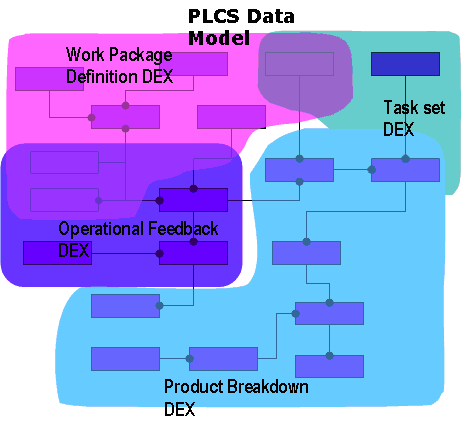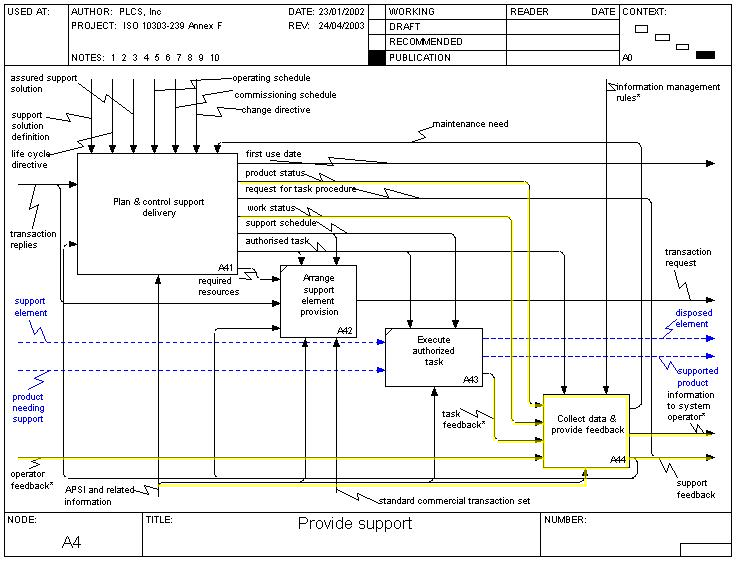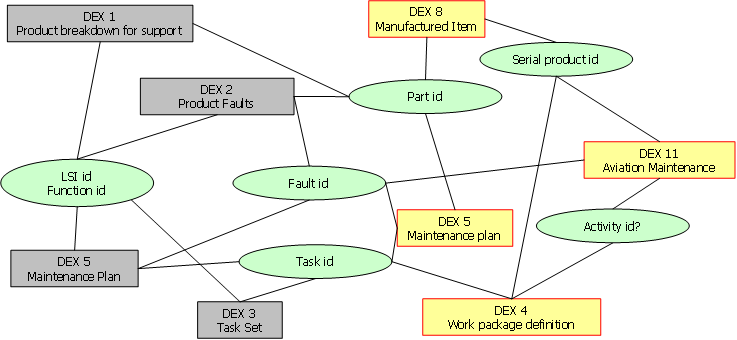| Help TOC > PLCS technical description > Data Exchange Specifications (DEXs)
|
| Data Exchange Specifications (DEXs) |
Date: 2008/03/06 22:22:10
Revision: 1.25
|
The information model defined by ISO 10303-239 PLCS
PLCS has a scope that is wider than
most applications or any single data exchange.
It is, therefore, unlikely that any software will be able to support or declare compliance to the
entire range of information supported by ISO 10303-239 PLCS.
Moreover, it would be impractical to contract for data compliant with ISO 10303-239 PLCS without a means of specifying the
scope required.
"Data EXchange specifications" ("DEXs")
are defined in order to constrain the full information model to the scope required. The way that DEX Schemas constitute
overlapping subsets of ISO 1030-239 PLCS information model is
illustrated in Figure 1.
has a scope that is wider than
most applications or any single data exchange.
It is, therefore, unlikely that any software will be able to support or declare compliance to the
entire range of information supported by ISO 10303-239 PLCS.
Moreover, it would be impractical to contract for data compliant with ISO 10303-239 PLCS without a means of specifying the
scope required.
"Data EXchange specifications" ("DEXs")
are defined in order to constrain the full information model to the scope required. The way that DEX Schemas constitute
overlapping subsets of ISO 1030-239 PLCS information model is
illustrated in Figure 1.
NOTE
A DEX is similar in purpose to a STEP AP Conformance Class, but supported by additional usage guidance (mainly in the Capabilities)
and Reference Data
AP Conformance Class, but supported by additional usage guidance (mainly in the Capabilities)
and Reference Data to ensure consistent implementation.
These additional features of DEXs ensure consistent implementation of the underlying EXPRESS
information model.
to ensure consistent implementation.
These additional features of DEXs ensure consistent implementation of the underlying EXPRESS
information model.
Figure 1 — DEX Schemas as overlapping subsets of ISO 1030-239 PLCS information model.
Definition:
Data Exchange Specification - a subset of the ISO 10303-239 PLCS information model, designed to support data
exchange for specific activities, providing guidance and rules for how to use and combine the selected entities
and external Reference Data in that exchange.
Each DEX includes a complete EXPRESS schema. This is a subset of the ISO 10303-239 schema with a derived XML
Schema. Both can be used to define and validate a data exchange file.
A DEX defined and managed by the OASIS PLCS TC may be referred to as a "PLCS DEX", as opposed to a "Business DEX".
The actual data (i.e. a package of data that is exchanged or shared,
or a data exchange file) that is in accordance with a DEX information model is referred to as
a DEX data set .
.
The DEXs are defined to support specific business processes.
A DEX may support a part of, one, or several information flows (arrows) from the PLCS Activity Model defined in AP239
defined in AP239 .
The PLCS DEXs can be used to:
.
The PLCS DEXs can be used to:
- Automate the process of populating one single Life Cycle PDM system;
- Automate an ongoing exchange of data between different IT systems that
are PLCS compliant and share the same information management rules; and
- Demonstrate compliance of a software application to an agreed set of
information management rules, based on the PLCS standard.
An example of a DEX is the aviation_maintenance
DEX which specifies how to use ISO 10303-239 (PLCS) to represent a record of work
that has been carried out on a complex product such as an aircraft. The arrows highlighted in
yellow in Figure 2 are the information flows that are supported by the DEX.
Figure 2 — Arrows in the PLCS activity model supported by the Aviation Maintenance DEX
In addition to identifying a subset of the ISO 10303-239 PLCS information model, there is a requirement
for guidance and rules for the consistent application and usage of different areas of that information model.
This is achieved through the use of "Capabilities" .
Each Capability describes how a particular generic business concept (such as a "part" or an "approval")
should be represented using a set of PLCS entities.
.
Each Capability describes how a particular generic business concept (such as a "part" or an "approval")
should be represented using a set of PLCS entities.
An example of a Capability used by the aviation_maintenance DEX is the
C001: assigning_identifiers (NB Capabilities are not documented in this release of the PLCS standard)
Capability which describes how to assign one or more identifiers to an object.
NOTE
Capabilities are in development and will be included in a future release.
See Capabilities for further details.
Within each Capability, patterns for structuring and instantiating data are provided in the form of "Templates" , which unambiguously define precisely
which PLCS entities are required and how they should be populated.
Each Capability defines one or more Templates and these form the building blocks of the data model that underlies each
DEX.
Each Template has just one parent Capability, but the Template may be used as a component of
several DEXs, ensuring that the same concept is represented consistently.
, which unambiguously define precisely
which PLCS entities are required and how they should be populated.
Each Capability defines one or more Templates and these form the building blocks of the data model that underlies each
DEX.
Each Template has just one parent Capability, but the Template may be used as a component of
several DEXs, ensuring that the same concept is represented consistently.
Examples of Templates defined by the
C001: assigning_identifiers (NB Capabilities are not documented in this release of the PLCS standard)
Capability and used in all DEXs are the
assigning_identification
and
assigning_identification_with_no_organization
Templates.
See Templates for further details.
The information model defined by ISO 10303-239 (PLCS) is generic. It holds no business specific terms.
These business semantics are represented by extending the PLCS information model through classification
with so called Reference Data (RD).
Reference Data allows for the semantic specialization (or grouping of elements) of the generic
information model
into Classes
(RD).
Reference Data allows for the semantic specialization (or grouping of elements) of the generic
information model
into Classes that make the context as specific as required for the data in question.
This provides a mechanism for adapting the generic model to the
requirements of more specialized domains. The use of the Reference Data is
identified within the DEXs, Templates and Capabilities.
The OASIS PLCS TC
that make the context as specific as required for the data in question.
This provides a mechanism for adapting the generic model to the
requirements of more specialized domains. The use of the Reference Data is
identified within the DEXs, Templates and Capabilities.
The OASIS PLCS TC specifies a mechanism for the definition (and extension) of Reference Data Classes,
and also defines a number of generic Reference Data Classes that may be specialized further by more specific Classes.
specifies a mechanism for the definition (and extension) of Reference Data Classes,
and also defines a number of generic Reference Data Classes that may be specialized further by more specific Classes.
Examples of Reference Data Classes used by the
C001: assigning_identifiers (NB Capabilities are not documented in this release of the PLCS standard)
Template are the
"Organization_identification_code"
(urn:plcs:rdl:std:Organization_identification_code)
and
"Organization_name"
(urn:plcs:rdl:std:Organization_name)
Classes.
These are used to indicate that an identifier used for an organization is, for example, a simple name or a formal identification
code.
If a formal identification code is indicated, more specialized Reference Data Classes may be used to specify that the
code in question is, for example, a "CAGE" code or a "DUNS" code.
See Reference data for further details.
A DEX can also be used as a standard against which software can claim conformance.
Conformant software is able to read and write data according to the DEX EXPRESS and XML schema a,
using the rules defined in Templates, and to interpret the OASIS
a,
using the rules defined in Templates, and to interpret the OASIS Reference Data Classes correctly.
Reference Data Classes correctly.
A DEX can also (and similarly) be used as the basis of a contractual deliverable,
although, in most cases, an additional Reference Data Library (RDL) would be required
in order to provide specific semantics.
If the generic PLCS DEX does not cover the scope of the contract completely, a
Business DEX
(RDL) would be required
in order to provide specific semantics.
If the generic PLCS DEX does not cover the scope of the contract completely, a
Business DEX may be required.
This is a further specialization of PLCS to
operate within a more constrained Business Context
may be required.
This is a further specialization of PLCS to
operate within a more constrained Business Context . The context may be a project,
an organization or enterprise. One or more Business DEXs may be defined within a context.
. The context may be a project,
an organization or enterprise. One or more Business DEXs may be defined within a context.
See Business DEXs for further details.
NOTE
In order to distinguish between the similar terms used for the components developed by
the OASIS PLCS TC and the business specific work, the terms may be prefixed "PLCS" or "OASIS" for
the standardization work, and "Business" for the business specific work. A DEX that is standardized
by the OASIS PLCS TC is then referred to as a "PLCS DEX" or as an "OASIS DEX", rather than a "Business DEX".
Different DEXs relate to different life cycle stages of a product.
Some of the ways in which DEXs relate to each other and the kinds of data they
share with each other is illustrated in Figure 3.
The oval shapes represent business level data that is created or referenced by a DEX.
Faults, Parts, Tasks etc. The Rectangles show the DEXs. The DEXs coloured grey indicate DEXs used
to represent data in the design phase of the product life cycle, and the DEXs coloured yellow
signify the DEXs used in the operational phase of the product life cycle.
Figure 3 — How DEXs relate to each other.
The documentation of a DEX provides a description of its purpose, an account of
the business process it supports, and usage guidance.
It lists the Templates used, and which Reference Data Classes are used,
and it provides an EXPRESS schema and an XML Schema that is derived from
the EXPRESS that represents the ISO 10303-239 PLCS subset.
Furthermore, it references the set of Capabilities that provide further usage guidance.
Each DEX is identified within the DEXlib repository by a number, an identifier and a name, e.g.
repository by a number, an identifier and a name, e.g.
- number — D001
- identifier — product_breakdown_for_support
- name — Product Breakdown for Support
Each DEX comprises the following:
-
"Introduction": an introduction, explaining the nature and purpose of the exchange specification;
-
"Scope": a scope statement, outlining the scope of the information covered by the DEX;
-
"ISO 10303-239 Activity model": a section that uses the ISO 10303-239 Activity model
to illustrate the business activities that are supported by the DEX;
-
"Business overview": a section that provides a high level overview of the business
process / application that the DEX is intended to support;
-
"Business information overview": a section that provides a high level overview of the
business information that can be represented by the DEX;
-
"Business information requirements": a section that provides a more detailed overview of the
information that the business process / application described in Business overview requires;
-
"ISO 10303-239 representation": a section that provides technical details of how the
business information requirements identified in Business information requirements are
represented using ISO 10303 239 PLCS;
- "Template": a section that lists all the Templates that are used in the definition of the DEX;
- "Capabilities": a section that lists all the Capabilities that provide usage guidance for the DEX;
-
Schemas" : a section that identifies the information models that define the DEX, namely:
- The EXPRESS model for the DEX;
- The XML Schema for the DEX derived from the EXPRESS according to ISO 10303-28 edition 2.
- "Reference data": a section that lists the Reference Data Classes used by the DEX;
- "Conformance": a section that defines the requirements for applications to conform to the DEX.
 PLCS
PLCS has a scope that is wider than
most applications or any single data exchange.
It is, therefore, unlikely that any software will be able to support or declare compliance to the
entire range of information supported by ISO 10303-239 PLCS.
Moreover, it would be impractical to contract for data compliant with ISO 10303-239 PLCS without a means of specifying the
scope required.
"Data EXchange specifications" ("DEXs")
are defined in order to constrain the full information model to the scope required. The way that DEX Schemas constitute
overlapping subsets of ISO 1030-239 PLCS information model is
illustrated in Figure 1.
has a scope that is wider than
most applications or any single data exchange.
It is, therefore, unlikely that any software will be able to support or declare compliance to the
entire range of information supported by ISO 10303-239 PLCS.
Moreover, it would be impractical to contract for data compliant with ISO 10303-239 PLCS without a means of specifying the
scope required.
"Data EXchange specifications" ("DEXs")
are defined in order to constrain the full information model to the scope required. The way that DEX Schemas constitute
overlapping subsets of ISO 1030-239 PLCS information model is
illustrated in Figure 1.


